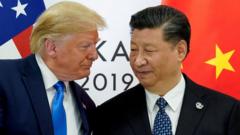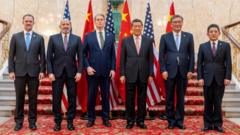After intense negotiations, the U.S. and China have reached a tentative agreement to roll back some trade measures, yet many experts believe it merely brings both nations back to a previous status quo, leaving unresolved issues hanging in the balance.
U.S.-China Trade Talks: Returning to the Status Quo after Tense Negotiations

U.S.-China Trade Talks: Returning to the Status Quo after Tense Negotiations
A recent handshake agreement between the U.S. and China eases trade tensions but raises questions about the effectiveness of prior aggressive tactics.
Article Text:
After two days of difficult negotiations, U.S. and Chinese officials have stepped back from the edge of a potentially severe economic clash, with a tentative handshake agreement reached early Wednesday in London. This deal aims to alleviate the damaging measures that both nations have imposed on each other's economies in a trade dispute that has escalated sharply in recent months.
However, there is skepticism about the longevity of this truce, particularly given that a similar accord formed in May quickly fell apart. Even if the new agreement remains in place, its primary outcome seems to be simply reverting the two countries to a state of affairs they had before aggressive trade actions intensified this past April, following U.S. President Trump's decision to increase tariffs on Chinese products.
As Myron Brilliant, a senior advisor at DGA-Albright Stonebridge Group, pointed out, “It seems like we’re negotiating in circles. You escalate, you de-escalate; at the end of the day we’re not really further along.”
Post-negotiation, tariffs are expected to remain unchanged. Specifics of the accord remain sparse, although it is anticipated that China will ease restrictions on exports of essential minerals threatening American manufacturing. In return, the U.S. is likely to moderate limits on its own exports of technology, alongside a reduction in threats concerning visas for Chinese students wishing to study in the United States.
The outcome reflects the complexity of the ongoing U.S.-China trade relationship and suggests that while immediate tensions may have abated, underlying issues continue to simmer beneath the surface.
After two days of difficult negotiations, U.S. and Chinese officials have stepped back from the edge of a potentially severe economic clash, with a tentative handshake agreement reached early Wednesday in London. This deal aims to alleviate the damaging measures that both nations have imposed on each other's economies in a trade dispute that has escalated sharply in recent months.
However, there is skepticism about the longevity of this truce, particularly given that a similar accord formed in May quickly fell apart. Even if the new agreement remains in place, its primary outcome seems to be simply reverting the two countries to a state of affairs they had before aggressive trade actions intensified this past April, following U.S. President Trump's decision to increase tariffs on Chinese products.
As Myron Brilliant, a senior advisor at DGA-Albright Stonebridge Group, pointed out, “It seems like we’re negotiating in circles. You escalate, you de-escalate; at the end of the day we’re not really further along.”
Post-negotiation, tariffs are expected to remain unchanged. Specifics of the accord remain sparse, although it is anticipated that China will ease restrictions on exports of essential minerals threatening American manufacturing. In return, the U.S. is likely to moderate limits on its own exports of technology, alongside a reduction in threats concerning visas for Chinese students wishing to study in the United States.
The outcome reflects the complexity of the ongoing U.S.-China trade relationship and suggests that while immediate tensions may have abated, underlying issues continue to simmer beneath the surface.






















